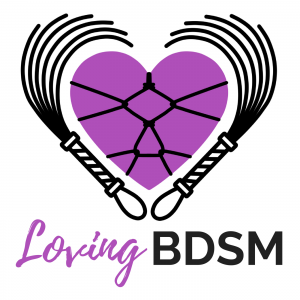Over the past few weeks, especially during the one year anniversary of the Loving BDSM podcast, John Brownstone and I received a ton of really good ideas for future podcast episodes. So many that we have a list that I have been tasked with organizing and scheduling for future episodes. Why? Because that’s how we roll.
Since I haven’t gotten around to the scheduling part (yet), we chose one that spoke to us and is a really important issue in BDSM (no matter what your dynamic is) – safewords.
If you’ve followed me for a little bit, you know how I feel: use them, don’t play with new people without one, etc. But the topic suggestion asked for something a little more. This person was looking for insight on when to use a safeword and when to let your boundaries be pushed.
As with all things BDSM and kink, everything is unique to you, but we definitely have opinions on safewords and couldn’t wait to share our thoughts. Remember, y’all, we’re one relationship, one dynamic, and one way of doing things. You have to find your own way in your own D/s relationship, but I really hope you include a safeword in there somewhere.
From the show:
- Looking for a vibrator to rip the orgasms from your submissive? Check out Good Vibes. They carry our personal favorite – the Original Magic Wand.
- Congratulations to the one year anniversary giveaway winner – Jen V.!
- This week’s episode comes from a listener who had specific (and good!) questions about figuring out when to safeword and when to allow your boundaries to be pushed.
- Safeword basics – what are they, how they work, and using gestures when words can’t be spoken.
- When should you use one – anytime you think it’s necessary because something doesn’t feel right: bad pain, fear, panic, an emotional reaction you didn’t expect, anything can be cause for a safeword.
- When a safeword is used, all play stops. Aftercare should be given. As soon as you’re able to, talk about why the safeword was used.
- Dominants should not rely only on a safeword, especially when you’re new to your D/s relationship. Watch body language. Check in and ask. The red-yellow-green system works well for this. Red means stop, yellow is slow down, and green means keep going.
- Safewords are to be used by a submissive whenever they feel its necessary but that comes with responsibility. If you intend to use (or have used) your safeword to get out of punishment or to get out of pre-negotiated task or responsibility, you need to talk to your Dominant about why you don’t want to do it. Relying on your safeword to get out of things you simply don’t like isn’t a healthy way to handle issues in D/s.
- Deciding whether a boundary is being pushed or you’re playing in an unsafe manner is a personal decision. Learn to listen to and trust your intuition, and when something doesn’t feel right, use your safeword – even if you can’t immediately explain why.
- BDSM and kink are fringe things and very emotional and mental. All kinds of old memories, issues, and fears can be triggered when you play. If this happens, use your safeword.
- If you continually use your safeword in every single play situation, you may set up a “crying wolf” scenario. Always use it if you need to, but talk to your partner about why you continually use it. Are fears being triggered? Do you really not enjoy that kind of play? You must communicate with one another.
- In our opinion (and others may disagree), the goal of your kinky play shouldn’t be to get to the safeword. The safeword means that you’re in a danger zone and something is wrong. Yes, boundaries should be pushed, and going until you can’t take anymore can be fun – but it can also be dangerous. To the Dominants, remember, don’t break your toys.
- Should Dominants have a safeword too? Not in our opinion because a Dominant is in control of the scene and the relationship. If something is bothering them, they can (and should!) stop when they need to but a safeword isn’t usually necessary for that. Only you can decide if you need one in your relationship.
- BONUS: After the “keep it kinky” sign off, we hung around and chatted about life, stuff going on, and random thoughts for a few minutes. If you’re interested, stick around for that part.
Listen to the show:
Listen on iTunes (and leave a review if you love what you hear!)
Or click the button below:
Image via Pixabay


Loving this. I’m always harping about safe words and hard limits being omitted from bdsm erotica/erom stories when they’re a brand new couple. It’s like.. no really, you can’t do that.. the sub is crying and scared, wtf are you doing? While in a book, it’s fiction, in real life it could mean so much more serious trouble that could have been prevented with one little thing… a conversation.
SO much can be prevented with a simple conversation. And yes, I wish I saw it more in fiction. For whatever reason, too many people get their BDSM “info” from erotica – which doesn’t make sense. Do people think they’re detectives because they read a murder mystery? I don’t understand it but I think working in the basics of safe, sane, and consensual in small ways would be nice.